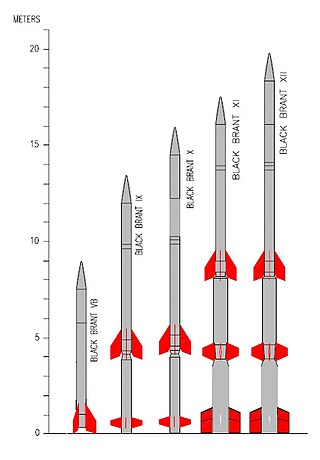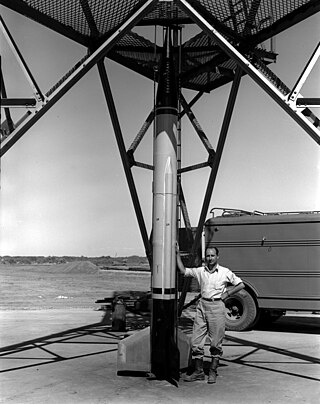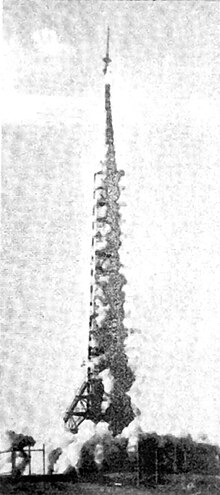
White Sands Missile Range (WSMR) is a United States Army military testing area and firing range located in the US state of New Mexico. The range was originally established in 1941 as the Alamogordo Bombing and Gunnery Range, where the Trinity test site lay at the northern end of the Range, in Socorro County near the towns of Carrizozo and San Antonio. It then became the White Sands Proving Ground on 9 July 1945.

The Black Brant is a family of Canadian-designed sounding rockets originally built by Bristol Aerospace, since absorbed by Magellan Aerospace in Winnipeg, Manitoba. Over 800 Black Brants of various versions have been launched since they were first produced in 1961, and the type remains one of the most popular sounding rockets. They have been repeatedly used by the Canadian Space Agency and NASA.
The Vanguard rocket was intended to be the first launch vehicle the United States would use to place a satellite into orbit. Instead, the Sputnik crisis caused by the surprise launch of Sputnik 1 led the U.S., after the failure of Vanguard TV-3, to quickly orbit the Explorer 1 satellite using a Juno I rocket, making Vanguard 1 the second successful U.S. orbital launch.

The Aerojet General X-8 was an unguided, spin-stabilized sounding rocket designed to launch a 150 lb (68 kg) payload to 200,000 feet (61.0 km). The X-8 was a version of the prolific Aerobee rocket family.
Aerojet was an American rocket and missile propulsion manufacturer based primarily in Rancho Cordova, California, with divisions in Redmond, Washington, Orange and Gainesville in Virginia, and Camden, Arkansas. Aerojet was owned by GenCorp. In 2013, Aerojet was merged by GenCorp with the former Pratt & Whitney Rocketdyne to form Aerojet Rocketdyne.

Loki, officially designated 76mm HEAA Rocket T220, was an American unguided anti-aircraft rocket based on the German Taifun. Like the Taifun, Loki never saw service in its original role, but later found widespread use as a sounding rocket. It was so successful in this role that several advanced versions were developed on the basic Loki layout, including the final Super Loki.

The WAC Corporal was the first sounding rocket developed in the United States and the first vehicle to achieve hypersonic speeds. It was an offshoot of the Corporal program, that was started by a partnership between the United States Army Ordnance Corps and the California Institute of Technology in June 1944 with the ultimate goal of developing a military ballistic missile.

The RTV-G-4 Bumper was a sounding rocket built by the United States. A combination of the German V-2 rocket and the WAC Corporal sounding rocket, it was used to study problems pertaining to two-stage high-speed rockets. The Bumper program launched eight rockets between May 13, 1948 and July 29, 1950. The first six flights were conducted at the White Sands Missile Range; the seventh launch, Bumper 8 on July 24, 1950, was the first rocket launched from Cape Canaveral.

The first orbital flight of an artificial satellite, Sputnik 1, was launched in October 1957, by the Soviet Union. In November, the second orbital flight took place. The Soviet Union launched the first animal to orbit the Earth, a dog, Laika, who died in orbit a few hours after launch.

Spaceflight as a practical endeavor began during World War II with the development of operational liquid-fueled rockets. Beginning life as a weapon, the V-2 was pressed into peaceful service after the war at the United States' White Sands Missile Range as well as the Soviet Union's Kapustin Yar. This led to a flourishing of missile designs setting the stage for the exploration of space. The small American WAC Corporal rocket was evolved into the Aerobee, a much more powerful sounding rocket. Exploration of space began in earnest in 1947 with the flight of the first Aerobee, 46 of which had flown by the end of 1950. These and other rockets, both Soviet and American, returned the first direct data on air density, temperature, charged particles and magnetic fields in the Earth's upper atmosphere.

This is a list of spaceflight related events which occurred in 1956.

In 1955, both the United States and the Soviet Union (USSR) announced plans for launching the world's first satellites during the International Geophysical Year (IGY) of 1957–58. Project Vanguard, proposed by the US Navy, won out over the US Army's Project Orbiter as the satellite and rocket design to be flown in the IGY. Development of Intercontinental Ballistic Missiles, the Atlas by the US and the R-7 by the USSR, accelerated, entering the design and construction phase.

The year 1954 saw the conception of Project Orbiter, the first practicable satellite launching project, utilizing the Redstone, a newly developed Short Range Ballistic Missile.

In 1952, several branches of the United States' military, often in partnership with civilian organizations, continued their programs of sounding rocket research beyond the 100 kilometres (62 mi) boundary of space using the Aerobee rocket. The University of Iowa launched its first series of rockoon flights, demonstrating the validity of the balloon-launched rocket, a comparatively inexpensive way to explore the upper atmosphere. The launch of Viking 9 at the end of the year to an altitude of 135 mi (217 km), by the Naval Research Laboratory team under the management of Milton Rosen, represented the pinnacle of contemporary operational rocket design.

The year 1951 saw extensive exploration of space by the United States and the Soviet Union (USSR) using suborbital rockets. The Soviets launched their first series of biomedical tests to the 100-kilometre (62 mi) boundary of space. Several American agencies launched more than a dozen scientific sounding rocket flights between them. The US Navy launched its Viking sounding rocket for the seventh time since 1949, this time to a record-breaking 136 miles (219 km) in August 1951.

The year 1953 saw the rockoon join the stable of sounding rockets capable of reaching beyond the 100 kilometres (62 mi) boundary of space. Employed by both the University of Iowa and the Naval Research Laboratory, 22 total were launched from the decks of the USS Staten Island and the USCGC Eastwind this year. All branches of the United States military continued their program of Aerobee sounding rocket launches, a total of 23 were launched throughout 1953. The Soviet Union launched no sounding rockets in 1953; however, the Soviet Union did conduct several series of missile test launches.

USS Desert Ship (LLS-1) is a concrete blockhouse providing assembly and launch facilities simulating shipboard conditions for Navy surface-to-air weapons testing at the Naval Air Warfare Center (NAWC) Weapons Division – White Sands.

The Orbital Maneuvering System (OMS) is a system of hypergolic liquid-propellant rocket engines used on the Space Shuttle and the Orion MPCV. Designed and manufactured in the United States by Aerojet, the system allowed the orbiter to perform various orbital maneuvers according to requirements of each mission profile: orbital injection after main engine cutoff, orbital corrections during flight, and the final deorbit burn for reentry. From STS-90 onwards the OMS were typically ignited part-way into the Shuttle's ascent for a few minutes to aid acceleration to orbital insertion. Notable exceptions were particularly high-altitude missions such as those supporting the Hubble Space Telescope (STS-31) or those with unusually heavy payloads such as Chandra (STS-93). An OMS dump burn also occurred on STS-51-F, as part of the Abort to Orbit procedure.

The RTV-A-3 NATIV was an experimental missile developed by North American Aviation for the United States Air Force in the late 1940s to test and evaluate guided missile technologies. The North American Test Instrumentation Vehicle (NATIV) was developed as part of the MX-770 program which was created towards the end of WWII with the intent of developing a long range missile.




















